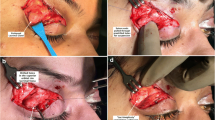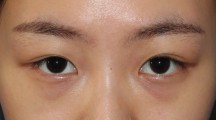Abstract
The lateral temporal fullness of the upper eyelid in patients presenting for a blepharoplasty is sometimes due to a prolapse of the lacrimal gland. The operative procedures that attempt to reposition the migrated lacrimal gland have been either dangerous in that they cause a dry-eye syndrome or unsatisfactory in that they have a high rate of recurrence or other complications. A new and different operative approach to a herniated or prolapsed lacrimal gland deals with an extraglandular concept of repositioning the gland that corresponds to the general principles of hernial surgery.
Similar content being viewed by others
References
Bosniak S: Ophthalmic plastic and reconstructive surgery in the United States: 1893–1970. Adv Ophthalmol Plast Reconstr Surg 5:241–281, 1986
Custer PhL, Tenzel RR, Kowalczyk AP: Blepharochalasis syndrome. Am J Ophthalmol 99:424–428, 1985
Duke-Elder S: The anatomy of the visual system. In: Duke-Elder S (ed): System of Ophthalmology. St. Louis: C.V. Mosby, 1975, vol 11, pp 450–467
Gobbels M: Das trockene Auge, Standortbestimmung und Aussichten. Fortschr Ophthalmol 87:190–197, 1990
Hinderer UT: Aging of the palpebral and periorbital regions. In: Gonzalez-Ulloa M (ed): Aesthetic Plastic Surgery. Padova: Piccin, 1987, vol 11, pp 1–93
Holly FJ, Lamberts DW, Buesseler JA: The human lacrimal apparatus: anatomy, physiology, pathology, and surgical aspects. Plast Reconstr Surg 74:438–445, 1984
Jordan DR, Germer BA, Anderson RL, Morales L: Lacrimal gland prolapse in craniosynostosis syndromes and poor function congenital ptosis. Ophthal Surg 21:97–101, 1990
Malcolm DP: The surgical management of upper eyelid hooding. Aesth Plast Surg 13:183–187, 1989
Miller CC: The excision of bag-like folds of skin from the region about the eyes: a classic reprint. Aesth Plast Surg 12:155–156, 1988
Plaza de la M, Arroyo JM: A new technique for the treatment of palpebral bags. Plast Reconstr Surg 81:677–685, 1988
Rochels R: Echographische diagnostik in der ophthalmologie. Fortsch Ophthalmol 86:524–529, 1989
Sakai T: Major ocular glands (harderian gland and lacrimal gland) of the musk shrew (Suncus murinus) (with a review on the comparative anatomy and histol ogy of the mammalian lacrimal glands). J Morphol 201:39–57, 1989
Smith B, Lisman RD: Dacryoadenopexy as a recognized factor in upper lid blepharoplasty. Plast Reconstr Surg 71:629–632, 1983
Smith B, Petrelli R: Surgical repair of prolapsed lacrimal glands. Arch Ophthalmol 96:1132, 1978
Werb A: The history and development of lacrimal surgery in England and Europe. Adv Ophthalmol Plast Reconstruct Surg 5:233–240, 1986
Author information
Authors and Affiliations
Additional information
Presented at the 29th Annual Meeting of the Austrian Society of Plastic, Aesthetic and Reconstructive Surgery, Graz, Austria, October 1991
Presented at the Annual Meeting of the Swiss Society of Plastic Surgery, Arlesheim, Basel, May 1992
Rights and permissions
About this article
Cite this article
Beer, G.M., Kompatscher, P. A new technique for the treatment of lacrimal gland prolapse in blepharoplasty. Aesth. Plast. Surg. 18, 65–69 (1994). https://doi.org/10.1007/BF00444250
Issue Date:
DOI: https://doi.org/10.1007/BF00444250




